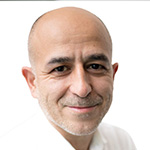TPS therapy: major advances in shock wave therapy
TV report shows new findings on shock waves in brain, heart and cancer treatment
I have been working with shockwaves for many years, both in research and in practice, and I am convinced that shockwave medicine is one of the best developments that medicine has produced in recent decades.
This applies to all the shockwave therapies with which we at the Professor Citak Health Center successfully work as key therapies, but also to the form of shockwave application that has been developed specifically for the field of neurodegenerative diseases over many decades of research: Transcranial Pulse Stimulation – or TPS therapy for short.
A 50-minute report on the history of shockwave medicine and the latest groundbreaking research results and findings has now been broadcast on the Austrian ORF (the equivalent of our ARD). As we are unfortunately unable to access the media library of the Austrian broadcaster ORF from Germany, you will find a summary of the documentary in written form below.
Shockwave medicine: a silent revolution that is only making waves today
Since the 1980s, doctors have been using shock waves to break up kidney stones – a procedure that many people are familiar with. But what many do not know: Science has not stood still since then – on the contrary. Researchers are now discovering that this technique can also work wonders in other medical fields. From treating Alzheimer’s, dementia and Parkinson’s to strokes, heart disease and possibly fighting cancer, shockwaves are showing impressive potential to help patients in new ways.
In the documentary “Healing Explosions – Revolution in Shockwave Therapy” from February 7, 2024, which is unfortunately only available in Austria in the ORF television media library, the ORF III channel gives an in-depth insight into this exciting development. It’s not just about how shockwaves work, but also about how doctors and physicists are working together to find solutions that can improve the lives and health of countless patients.
Shock waves: The key to their effect lies in regeneration
The most impressive thing about shockwaves? Their ability to naturally regenerate the body. Without major surgery, this technology can significantly change the way treatment options are used in various medical specialties and open new doors for therapy.
In this article, we review the 50-minute ORF report, focusing primarily on the regenerative effects that shockwaves can have, and share the latest findings and success stories from the scientific community.
From combat technique to groundbreaking treatments: The journey of shockwave therapy
The story of how shockwaves found their way into medicine is almost like an adventure novel. Initially researched in the military for their destructive aspects, they have undergone an astonishing transformation. In the 1980s, doctors began using them for something completely different: to dissolve kidney stones. This method, known as lithotripsy, quickly became a gentle alternative to conventional surgery by simply fragmenting the stones – without any incisions or painful, long rehabilitation periods. Today, lithotripsy is the global standard.
Shock waves have already established themselves in orthopaedics
As a result, extracorporeal shock wave therapy (ESWT) has emerged as one of the most exciting innovations in orthopaedics. Since the 1990s, this form of shockwave technology has used much lower energies than lithotripsy to help reduce pain and minimize or heal tendon and muscle complaints in the shortest possible time – and all without surgery. Whether for sports injuries such as tennis elbow or long-term problems such as heel spurs, ESWT uses the power of shock waves to help the body regenerate itself. This makes it an important option in modern orthopaedics and has long since established itself as a treatment of choice in the field of orthopaedics.
Exciting new fields of research: Shockwave therapy and its future
But shockwave therapy is not only making waves in orthopaedics. Researchers are now also looking at exciting possibilities in cardiac medicine, neurology and even in the fight against cancer. These new areas of application could lead to a paradigm shift in the therapeutic landscape and also revolutionize the way we still think about medical treatment today.
Revolutionary treatment: shock waves show impressive results on the heart
“The mechanism of action that we have discovered in the laboratory does not only apply to the heart, but is the same in all tissues and all organs,” explains Priv.-Doz. Dr. Johannes Hohlfeld from the Medical University of Innsbruck, who habilitated on cardiac shock waves, explains in the documentation: “At the end of an operation, when the patient is still connected to the heart-lung machine – that’s the safety net – the small transducer is moved around the heart and the previously defined, diseased areas are treated.”
A milestone in cardiac medicine: early end of a study confirms success
The research results from Innsbruck are indeed breathtaking. “We have achieved a truly spectacular result,” says Johannes Holfeld. In fact, the effects of the shock wave on the heart are so impressive that the study was ended early by the ethics committee so that all patients could receive the effective treatment immediately. It is particularly remarkable that these patients had already been treated unsuccessfully with all available drugs and were considered to be out of therapy.
“We are literally waking the heart muscle up as if from hibernation,” summarizes study leader Holfeld, “by growing new blood vessels thanks to the shock wave. This allows us to actually regain relevant areas of the heart muscle.”
Shock waves in medicine: the journey from stone fragmentation to holistic regeneration
Shock waves were long thought to have a similar effect on the body as micro-trauma. But science has shown: The regenerative effects of shockwave therapy are based on a completely different principle. This discovery opens new doors for the treatment of heart disease and beyond.
“For a very long time, shockwaves were in the voodoo corner,” reports Dr. Wolfgang Schaden, a leading international figure in shockwave research and application. This was because the exact effects of shock waves on the body were not fully understood for a long time. Many people were therefore skeptical about this method. However, the tide has clearly turned in recent years, as the ORF documentary shows.
Shockwave treatment is actually based on a fascinating principle that has now been scientifically proven: it transforms mechanical energy into healing processes in the body. This process, known as mechanotransduction, can help to significantly accelerate nerve regeneration and wound healing, for example. These findings open up completely new perspectives for medical research and treatment.
Shock waves: A deep look into the world of cells opens up new treatment horizons
The group of scientists led by Johannes Hohlfeld at the University of Innsbruck has now made groundbreaking discoveries about how shock waves affect our cells. They discovered that the shock waves detach tiny bubbles from the cell surfaces. The special thing about this is that the cells remain intact because they are flexible and not rigid. These tiny vesicles play a key role – they activate an important part of our immune system and can thus induce the body to regenerate itself. Equally exciting is the growing assumption that shock waves could trigger a kind of natural stem cell therapy.
From brain to spinal cord: shock waves as a beacon of hope
However, shock waves have amazing effects not only in heart medicine, but also in brain diseases. Transcranial Pulse Stimulation (TPS) is already being used successfully in numerous clinics and practices to treat patients with Alzheimer’s, Parkinson’s, depression and other neurological diseases. The success of this method, which is based on extremely low-energy shock waves, is increasingly supported by scientific studies and investigations.
But the research goes even further: the focus is also on the nerve tissue in the spinal cord. There is great hope that shock waves could one day help to reduce or even prevent the consequences of spinal cord injuries such as paraplegia.
New approaches in cancer research: shockwave therapy comes into focus
Could shockwave therapy offer new hope in the fight against cancer? The ORF documentary asks this question and looks at promising research, including at the Charité in Berlin. An innovative approach is being pursued there: instead of destroying cancer cells directly, shockwave therapy could help to make metastases “visible” and thus support the immune system in fighting cancer more effectively. The first studies have already begun and are showing encouraging results.
One impressive example is the case of a patient who could not be cured despite being diagnosed with melanoma (black skin cancer) and numerous attempts at treatment, including chemotherapy and radiotherapy. The turning point came with a combination of immunotherapy and targeted shockwave therapy on a skin metastasis. Not only did this metastasis disappear after a few sessions, but amazingly all other metastases in the patient’s body also disappeared. There was a remarkable systemic effect – treatment at one site led to improvement throughout the entire body.
On the road to better medicine: the promising role of shockwave therapy
Shockwave therapy is at an exciting point in its development. It is already being used in areas such as urology and orthopaedics and could soon make important contributions in neurology, cardiology and even cancer treatment. The big advantage of this method? Its safety. With over six million successful treatments in the US alone, even at high energy levels, shockwave therapy has been shown to cause no serious side effects. This makes it a promising alternative for many patients looking for gentle treatment options.
The future of shockwave therapy therefore looks promising. Scientists are continuing to work hard to unlock its full potential and give even more people access to these advanced treatment methods.


